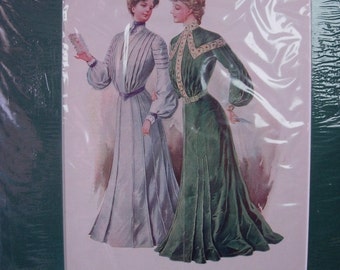I made Simplicity 2890 in May. It went together very easily. I was excited about it. I loved the fabric--a vintage tablecloth that a friend had given me, with dogwoods printed on a pale yellow background. I thought the bust cups were going to be too big but they were actually perfect. Then came the moment to try it on, and that's when two of the grommets ripped out during lacing. I guess the fabric was too old and brittle. I was completely and utterly bummed out.
I made version two in last month (November) and from the get-go it was a whole different beast. I had lots of problems this time. I installed the bust and hip gores the same way I did for the first version, but the bust didn't flare out as much as the first one. I am rather top-heavy, so I need that flare.
I plugged away at it. I folded the back edge to the inside to form the back lacing strips, and for some reason, the facing ended up coming to the middle of the back hip gores. Wtf??? So I had to put a facing on the back to form the lacing strips, which I knew was almost certainly going to make the corset too big.
I plugged away at it. I'd chosen a supposedly 100% cotton, tightly woven home decor fabric for the corset. It was pink. As I began working on the corset, I realized I loathed that color. Once, when I was 12, I had the flu really bad. Fever, chills, etc. My parents got me a strawberry shake from McDonald's to make me feel better. I drank the entire shake, and then a few minutes later, barfed it all right back up into my Strawberry Shortcake trash can by the bed. The barf was the same exact shade of pink as this corset fabric. That's all I could think of. So I dyed it.
 | ||||
| That pale pink is the back facing for the back lacing panels. That's the original color of my corset fabric. |
I plugged away at it. One fine day, I went to my parents' house to pound the grommets in using my dad's nice work table. The fabric got all warped and fucked up looking with each hole I made with the awl. I don't think I have pictures of that.
ANYWAY, to make a short story long, I finished the corset, tried it on, and the bust is too small and somehow the sits too low and I can't make it work after all that. Here's some damn pictures of the damn corset anyway.
 |
| See how the bust sits too low? |
 |
| Side view showing how my boobs are about to fall out of the corset. |
 |
| Back showing how the corset ended up being too big because of the facing I had to add to the back. |
 |
| Hmmmm.... Nope. |
Also, there is major wrinkling at the waist. How does this happen, and what would I need to do to fix it IF I was going to gut this corset for the boning and busk and try this pattern again?
Fitting advice would be much appreciated, if anyone has some. Also, has this taught me to start making muslins? Yes, it has.
I am thinking of just having one custom made by Kay Gnagey. Hers are around $120-$130, so very reasonably priced. I had one once, years ago when I had a job doing living history from time to time, and I loved it. The only drawback is that her ETA is 3-4 months from date of order.













































